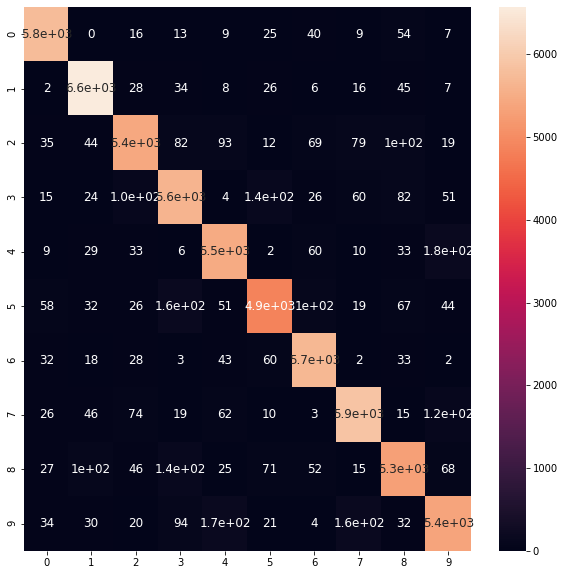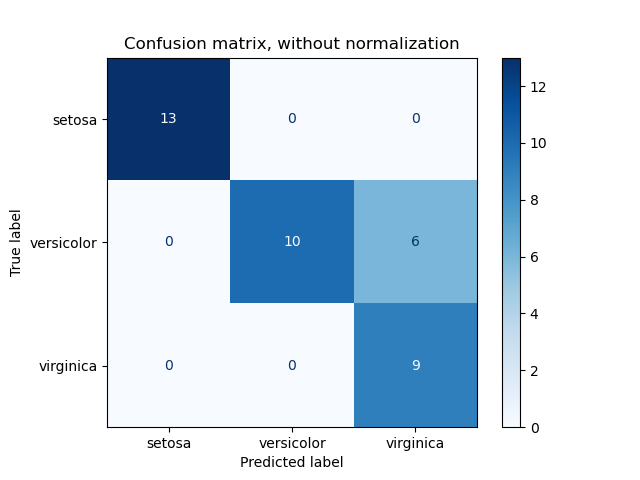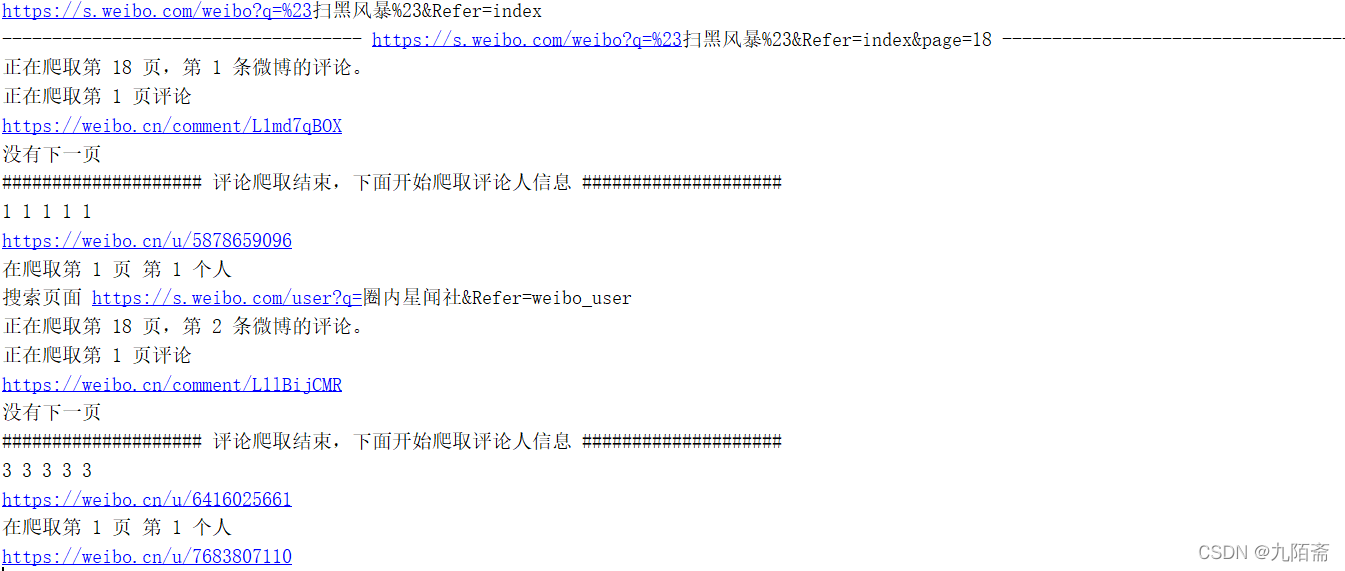如何计算测试数据的混淆矩阵?
如何计算测试数据的混淆矩阵?
提问于 2021-02-13 16:52:18
我想在验证数据上绘制一个混淆矩阵。
具体来说,我想对验证数据计算模型输出的混淆矩阵。
我在网上什么都试过了,但搞不懂。
这是我的模型:
import tensorflow as tf
from tensorflow.keras import datasets, layers, models
(train_images, train_labels), (test_images, test_labels) = datasets.cifar10.load_data()
train_images, test_images = train_images / 255.0, test_images / 255.0
model = models.Sequential()
# layers here
model.compile(optimizer='adam',
loss=tf.keras.losses.SparseCategoricalCrossentropy(from_logits=True),
metrics=['accuracy'])
history = model.fit(train_images, train_labels, epochs=1,
validation_data=(test_images, test_labels))回答 3
Stack Overflow用户
回答已采纳
发布于 2021-02-13 17:00:13
下面是一个虚拟的例子。
DataSet
(x_train, y_train), (x_test, y_test) = tf.keras.datasets.mnist.load_data()
# train set / data
x_train = x_train.reshape(-1, 28*28)
x_train = x_train.astype('float32') / 255
# train set / target
num_of_classess = 10
y_train = tf.keras.utils.to_categorical(y_train , num_classes=num_of_classess )模型
model = Sequential()
model.add(Dense(800, input_dim=784, activation="relu"))
model.add(Dense(num_of_classess , activation="softmax"))
model.compile(loss="categorical_crossentropy", optimizer="SGD", metrics=["accuracy"])
history = model.fit(x_train, y_train,
batch_size=200,
epochs=20,
verbose=1)混淆矩阵
你的兴趣主要集中在这里。
# get predictions
y_pred = model.predict(x_train, verbose=2)
# compute confusion matrix with `tf`
confusion = tf.math.confusion_matrix(
labels = np.argmax(y_train, axis=1), # get trule labels
predictions = np.argmax(y_pred, axis=1), # get predicted labels
num_classes=num_of_classess) # no. of classifier
print(confusion)
<tf.Tensor: shape=(10, 10), dtype=int32, numpy=
array([[5750, 0, 16, 13, 9, 25, 40, 9, 54, 7],
[ 2, 6570, 28, 34, 8, 26, 6, 16, 45, 7],
[ 35, 44, 5425, 82, 93, 12, 69, 79, 100, 19],
[ 15, 24, 105, 5628, 4, 136, 26, 60, 82, 51],
[ 9, 29, 33, 6, 5483, 2, 60, 10, 33, 177],
[ 58, 32, 26, 159, 51, 4864, 101, 19, 67, 44],
[ 32, 18, 28, 3, 43, 60, 5697, 2, 33, 2],
[ 26, 46, 74, 19, 62, 10, 3, 5895, 15, 115],
[ 27, 101, 46, 142, 25, 71, 52, 15, 5304, 68],
[ 34, 30, 20, 94, 173, 21, 4, 162, 32, 5379]],
dtype=int32)>Visualization
让我们想象一下。
import seaborn as sns
import pandas as pd
cm = pd.DataFrame(confusion.numpy(), # use .numpy(), because now confusion is tensor
range(num_of_classess),range(num_of_classess))
plt.figure(figsize = (10,10))
sns.heatmap(cm, annot=True, annot_kws={"size": 12}) # font size
plt.show()

更新
基于对话,如果你要用
tf.keras.losses.SparseCategoricalCrossentropy(from_logits=True)然后,不要像我前面展示的那样转换整数标签(即y_train = tf.keras.utils.to_categorical(y_train, num_classes=10))。但如下所示
(x_train, y_train), (x_test, y_test) = tf.keras.datasets.cifar10.load_data()
# train set / data
x_train = x_train.astype('float32') / 255
print(x_train.shape, y_train.shape)
# (50000, 32, 32, 3) (50000, 1)
model ...
model.compile(
loss=tf.keras.losses.SparseCategoricalCrossentropy(from_logits=True),
....
)在预测时间时,不要使用np.argmax() on ,地面真理,,因为它们现在已经是一个整数,因为我们这次没有使用tf.keras.utils.to_categorical。
print(np.argmax(y_pred, axis=1).shape, y_train.reshape(-1).shape)
# (50000,) (50000,)
y_pred = model.predict(x_train, verbose=2) # take prediction
confusion = tf.math.confusion_matrix(
labels = y_train.reshape(-1), # get trule labels
predictions = np.argmax(y_pred, axis=1), # get predicted labels
) 现在剩下的东西可以用了。
Stack Overflow用户
发布于 2021-02-13 16:59:46
应该相当直截了当。
test_labels = np.array([0,0,1,1,2,2,3,3,3]) #actual labels
test_pred = np.array([0,1,1,1,1,2,3,3,0]) #predicted labels
cf = tf.math.confusion_matrix(test_labels, test_pred)
pd.DataFrame(cf.numpy(), columns=[0,1,2,3], index=[0,1,2,3]) 0 1 2 3
0 1 1 0 0
1 0 2 0 0
2 0 1 1 0
3 1 0 0 2确保您正在应用np.argmax over axis=1 on test_pred,以确保它的1D带有标签,而不是像这样的2D逻辑
test_pred = np.argmax(model.predict(test_images), axis=1)Stack Overflow用户
发布于 2021-02-13 17:05:21
另外,一旦您将混淆矩阵作为一个numpy数组,您就可以很容易地用sklearn's ConfusionMatrixDisplay绘制它。
from sklearn.metrics import ConfusionMatrixDisplay
def plot_cm(cm):
ConfusionMatrixDisplay(cm).plot()

页面原文内容由Stack Overflow提供。腾讯云小微IT领域专用引擎提供翻译支持
原文链接:
https://stackoverflow.com/questions/66191450
复制相关文章
相似问题







